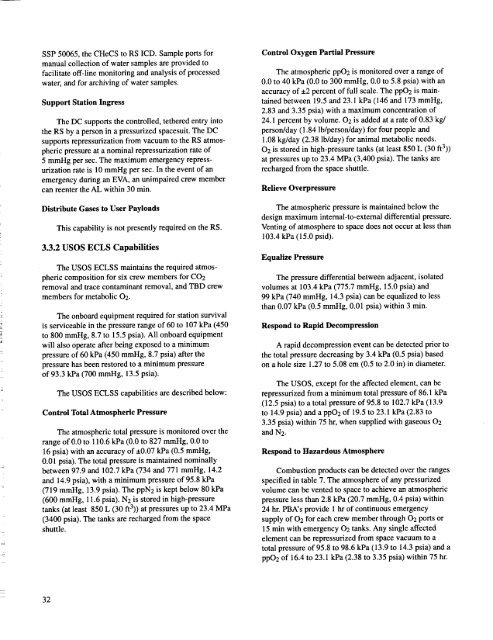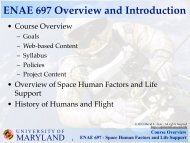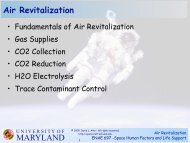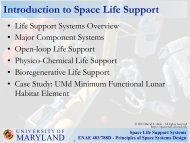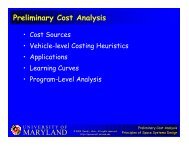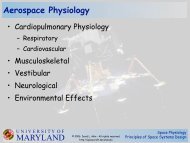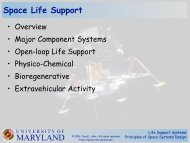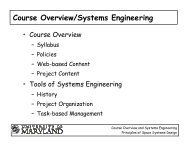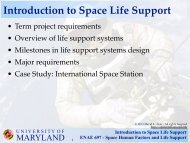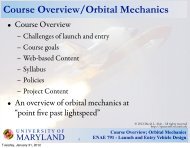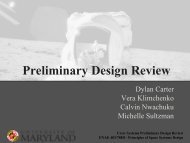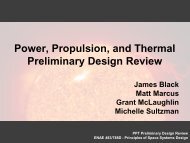Living Together in Space: The Design and Operation of the Life ...
Living Together in Space: The Design and Operation of the Life ...
Living Together in Space: The Design and Operation of the Life ...
Create successful ePaper yourself
Turn your PDF publications into a flip-book with our unique Google optimized e-Paper software.
SSP50065, <strong>the</strong>CHeCStoRSICD. Sample ports for<br />
manual collection <strong>of</strong> water samples are provided to<br />
facilitate <strong>of</strong>f-l<strong>in</strong>e monitor<strong>in</strong>g <strong>and</strong> analysis <strong>of</strong> processed<br />
water, <strong>and</strong> for archiv<strong>in</strong>g <strong>of</strong> water samples.<br />
Support Station Ingress<br />
<strong>The</strong> DC supports <strong>the</strong> controlled, te<strong>the</strong>red entry <strong>in</strong>to<br />
<strong>the</strong> RS by a person <strong>in</strong> a pressurized spacesuit. <strong>The</strong> DC<br />
supports repressurization from vacuum to <strong>the</strong> RS atmos-<br />
pheric pressure at a nom<strong>in</strong>al repressurization rate <strong>of</strong><br />
5 mmHg per sec. <strong>The</strong> maximum emergency repress-<br />
urization rate is l0 mmHg per sec. In <strong>the</strong> event <strong>of</strong> an<br />
emergency dur<strong>in</strong>g an EVA, an unimpaired crew member<br />
can reenter <strong>the</strong> AL with<strong>in</strong> 30 m<strong>in</strong>.<br />
Distribute Gases to User Payloads<br />
This capability is not presently required on <strong>the</strong> RS.<br />
3.3.2 USOS ECLS Capabilities<br />
<strong>The</strong> USOS ECLSS ma<strong>in</strong>ta<strong>in</strong>s <strong>the</strong> required atmos-<br />
pheric composition for six crew members for CO 2<br />
removal <strong>and</strong> trace contam<strong>in</strong>ant removal, <strong>and</strong> TBD crew<br />
members for metabolic 02.<br />
<strong>The</strong> onboard equipment required for station survival<br />
is serviceable <strong>in</strong> <strong>the</strong> pressure range <strong>of</strong> 60 to 107 kPa (450<br />
to 800 mmHg, 8.7 to 15.5 psia). All onboard equipment<br />
will also operate after be<strong>in</strong>g exposed to a m<strong>in</strong>imum<br />
pressure <strong>of</strong> 60 kPa (450 mmHg, 8.7 psia) after <strong>the</strong><br />
pressure has been restored to a m<strong>in</strong>imum pressure<br />
<strong>of</strong> 93.3 kPa (700 mmHg, 13.5 psia).<br />
<strong>The</strong> USOS ECLSS capabilities are described below:<br />
Control Total Atmospheric Pressure<br />
<strong>The</strong> atmospheric total pressure is monitored over <strong>the</strong><br />
range <strong>of</strong> 0.0 to 110.6 kPa (0.0 to 827 mmHg, 0.0 to<br />
16 psia) with an accuracy <strong>of</strong> +0.07 kPa (0.5 mmHg,<br />
0.01 psia). <strong>The</strong> total pressure is ma<strong>in</strong>ta<strong>in</strong>ed nom<strong>in</strong>ally<br />
between 97.9 <strong>and</strong> 102.7 kPa (734 <strong>and</strong> 771 mmHg, 14.2<br />
<strong>and</strong> 14.9 psia), with a m<strong>in</strong>imum pressure <strong>of</strong> 95.8 kPa<br />
(719 mmHg, 13.9 psia). <strong>The</strong> ppN2 is kept below 80 kPa<br />
(600 mmHg, I 1.6 psia). N2 is stored <strong>in</strong> high-pressure<br />
tanks (at least 850 L (30 ft3)) at pressures up to 23.4 MPa<br />
(3400 psia). <strong>The</strong> tanks are recharged from <strong>the</strong> space<br />
shuttle.<br />
32<br />
Control Oxygen Partial Pressure<br />
<strong>The</strong> atmospheric ppO2 is monitored over a range <strong>of</strong><br />
0.0 to 40 kPa (0.0 to 300 mmHg, 0.0 to 5.8 psia) with an<br />
accuracy <strong>of</strong> +2 percent <strong>of</strong> full scale. <strong>The</strong> ppO2 is ma<strong>in</strong>-<br />
ta<strong>in</strong>ed between 19.5 <strong>and</strong> 23.1 kPa (146 <strong>and</strong> 173 mmHg,<br />
2.83 <strong>and</strong> 3.35 psia) with a maximum concentration <strong>of</strong><br />
24. l percent by volume. 02 is added at a rate <strong>of</strong> 0.83 kg/<br />
person/day (1.84 lb/persotVday) for four people <strong>and</strong><br />
1.08 kg/day (2.38 lb/day) for animal metabolic needs.<br />
O2 is stored <strong>in</strong> high-pressure tanks (at least 850 L (30 ft3))<br />
at pressures up to 23.4 MPa (3,400 psia). <strong>The</strong> tanks are<br />
recharged from <strong>the</strong> space shuttle.<br />
Relieve Overpressure<br />
<strong>The</strong> atmospheric pressure is ma<strong>in</strong>ta<strong>in</strong>ed below <strong>the</strong><br />
design maximum <strong>in</strong>ternal-to-external differential pressure.<br />
Vent<strong>in</strong>g <strong>of</strong> atmosphere to space does not occur at less than<br />
103.4 kPa (15.0 psid).<br />
Equalize Pressure<br />
<strong>The</strong> pressure differential between adjacent, isolated<br />
volumes at 103.4 kPa (775.7 mmHg, 15.0 psia) <strong>and</strong><br />
99 kPa (740 mmHg, 14.3 psia) can be equalized to less<br />
than 0.07 kPa (0.5 mmHg, 0.01 psia) with<strong>in</strong> 3 m<strong>in</strong>.<br />
Respond to Rapid Decompression<br />
A rapid decompression event can be detected prior to<br />
<strong>the</strong> total pressure decreas<strong>in</strong>g by 3.4 kPa (0.5 psia) based<br />
on a hole size 1.27 to 5.08 cm (0.5 to 2.0 <strong>in</strong>) <strong>in</strong> diameter.<br />
<strong>The</strong> USOS, except for <strong>the</strong> affected element, can be<br />
repressurized from a m<strong>in</strong>imum total pressure <strong>of</strong> 86.1 kPa<br />
(12.5 psia) to a total pressure <strong>of</strong> 95.8 to 102.7 kPa (13.9<br />
to 14.9 psia) <strong>and</strong> a ppO2 <strong>of</strong> 19.5 to 23.1 kPa (2.83 to<br />
3.35 psia) with<strong>in</strong> 75 hr, when supplied with gaseous O2<br />
<strong>and</strong> N2.<br />
Respond to Hazardous Atmosphere<br />
Combustion products can be detected over <strong>the</strong> ranges<br />
specified <strong>in</strong> table 7. <strong>The</strong> atmosphere <strong>of</strong> any pressurized<br />
volume can be vented to space to achieve an atmospheric<br />
pressure less than 2.8 kPa (20.7 mmHg, 0.4 psia) with<strong>in</strong><br />
24 hr. PBA's provide 1 hr <strong>of</strong> cont<strong>in</strong>uous emergency<br />
supply <strong>of</strong> 02 for each crew member through 02 ports or<br />
15 m<strong>in</strong> with emergency 02 tanks. Any s<strong>in</strong>gle affected<br />
element can be repressurized from space vacuum to a<br />
total pressure <strong>of</strong> 95.8 to 98.6 kPa (13.9 to 14.3 psia) <strong>and</strong> a<br />
ppO2 <strong>of</strong> 16.4 to 23.1 kPa (2.38 to 3.35 psia) with<strong>in</strong> 75 hr.


